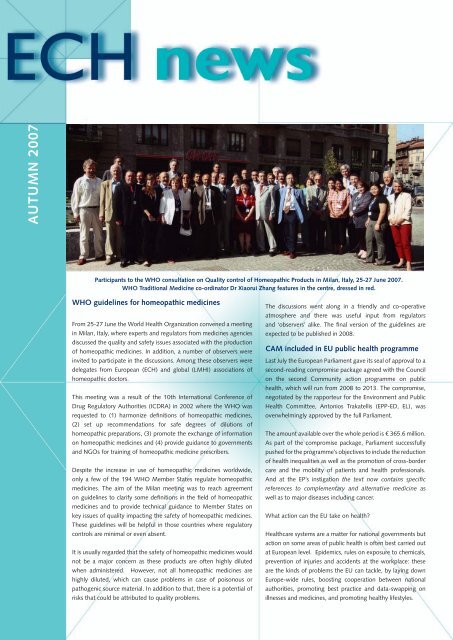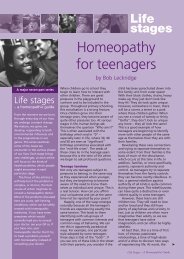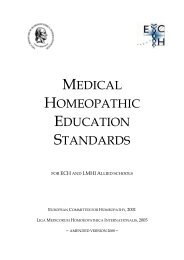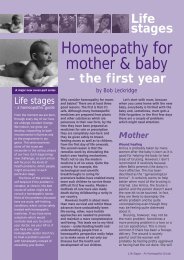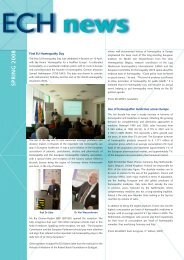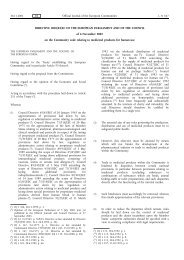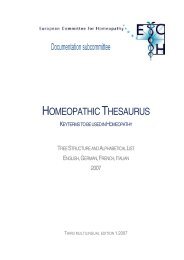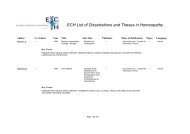English - European Committee for Homeopathy
English - European Committee for Homeopathy
English - European Committee for Homeopathy
You also want an ePaper? Increase the reach of your titles
YUMPU automatically turns print PDFs into web optimized ePapers that Google loves.
AUTUMN 2007Participants to the WHO consultation on Quality control of Homeopathic Products in Milan, Italy, 25-27 June 2007.WHO Traditional Medicine co-ordinator Dr Xiaorui Zhang features in the centre, dressed in red.WHO guidelines <strong>for</strong> homeopathic medicinesFrom 25-27 June the World Health Organization convened a meetingin Milan, Italy, where experts and regulators from medicines agenciesdiscussed the quality and safety issues associated with the productionof homeopathic medicines. In addition, a number of observers wereinvited to participate in the discussions. Among these observers weredelegates from <strong>European</strong> (ECH) and global (LMHI) associations ofhomeopathic doctors.This meeting was a result of the 10th International Conference ofDrug Regulatory Authorities (ICDRA) in 2002 where the WHO wasrequested to (1) harmonize definitions of homeopathic medicines,(2) set up recommendations <strong>for</strong> safe degrees of dilutions ofhomeopathic preparations, (3) promote the exchange of in<strong>for</strong>mationon homeopathic medicines and (4) provide guidance to governmentsand NGOs <strong>for</strong> training of homeopathic medicine prescribers.Despite the increase in use of homeopathic medicines worldwide,only a few of the 194 WHO Member States regulate homeopathicmedicines. The aim of the Milan meeting was to reach agreementon guidelines to clarify some definitions in the field of homeopathicmedicines and to provide technical guidance to Member States onkey issues of quality impacting the safety of homeopathic medicines.These guidelines will be helpful in those countries where regulatorycontrols are minimal or even absent.It is usually regarded that the safety of homeopathic medicines wouldnot be a major concern as these products are often highly dilutedwhen administered. However, not all homeopathic medicines arehighly diluted, which can cause problems in case of poisonous orpathogenic source material. In addition to that, there is a potential ofrisks that could be attributed to quality problems.The discussions went along in a friendly and co-operativeatmosphere and there was useful input from regulatorsand ‘observers’ alike. The final version of the guidelines areexpected to be published in 2008.CAM included in EU public health programmeLast July the <strong>European</strong> Parliament gave its seal of approval to asecond-reading compromise package agreed with the Councilon the second Community action programme on publichealth, which will run from 2008 to 2013. The compromise,negotiated by the rapporteur <strong>for</strong> the Environment and PublicHealth <strong>Committee</strong>, Antonios Trakatellis (EPP-ED, EL), wasoverwhelmingly approved by the full Parliament.The amount available over the whole period is € 365.6 million.As part of the compromise package, Parliament successfullypushed <strong>for</strong> the programme’s objectives to include the reductionof health inequalities as well as the promotion of cross-bordercare and the mobility of patients and health professionals.And at the EP’s instigation the text now contains specificreferences to complementary and alternative medicine aswell as to major diseases including cancer.What action can the EU take on health?Healthcare systems are a matter <strong>for</strong> national governments butaction on some areas of public health is often best carried outat <strong>European</strong> level. Epidemics, rules on exposure to chemicals,prevention of injuries and accidents at the workplace: theseare the kinds of problems the EU can tackle, by laying downEurope-wide rules, boosting cooperation between nationalauthorities, promoting best practice and data-swapping onillnesses and medicines, and promoting healthy lifestyles.
First <strong>European</strong> Dialogue Forum in BrusselsThe first <strong>European</strong> Dialogue Forum “The Patient between Conventionaland Complementary Medicine” took place on 18 October at theBaden-Württemberg embassy in Brussels. It was organised by theInstitute of Social Medicine, Epidemiology and Health Economics ofthe Charité University in Berlin (Professor Dr Stefan Willich).The Dialogue Forum originates from Germany, where over thepast few years mainstream and CAM doctors have had regulardiscussions at the Dialog<strong>for</strong>um Pluralismus in der Medizin (DialogueForum <strong>for</strong> Pluralism in Medicine), presided by the chairman of theGerman Medical Association, Prof. Dr. med. Jörg-Dietrich Hoppe.Its aim is to provide a structured dialogue between mainstream andcomplementary medicine eventually leading to an integration of bothareas.This initiative has now been brought to the <strong>European</strong> level and itaims to (1) provide guidance to safe and effective integrated care, (2)develop appropriate medical education, (3) foster scientific progressin CAM, (4) support appropriate <strong>European</strong> legislation, (5) benefitpatients and their physicians by adequate therapeutic choice.public. Only owing to the courage of Caroline Kramer thecampaign went public and could be stopped. Of course,Caroline Kramer was dismissed, which is the usual consequence<strong>for</strong> whistleblowers. Caroline Kramer: “Still I would do it again.Influencing the public opinion be<strong>for</strong>e a parliamentary decisionand even financed with our tax money, I thought that wasnot possible in Switzerland”. In September she was grantedthe ‘Prix Courage 2007’ including 10,000 Swiss Francs(approximately € 6,000).Database of homeopathic plant remediesA database on plants and fungi used in homeopathy hasbeen launched on the website of the Natural History Museumlocated in London, United Kingdom. It contains details ofhundreds of plants and fungi as well as lichens, brown andred algae. The database reconciles the old homeopathic codeswith the current botanical code. The in<strong>for</strong>mation is basedon long established remedies in the Homeopathic MateriaeMedicae that are now revised and updated and the onlineaccess means it can be maintained and updated easily in linewith current concepts of botanical nomenclature.Approximately a hundred people attended. Un<strong>for</strong>tunately,representatives from <strong>European</strong> Commission, <strong>European</strong> Parliament(including Mr Trakatellis) and CPME (Standing <strong>Committee</strong> of<strong>European</strong> Doctors) declined the invitation or did not respond to it.Patients’ associations were hardly represented either.Speakers were Professor Jörg-Dietrich Hoppe, Professor Stefan Willich,Professor Robert Jütte (Institute <strong>for</strong> the History of Medicine, Stuttgart,Germany), Dr Elio Rossi (Consultant of the Regional Ministry ofHealth of Tuscany, Italy), Dr Claudia Witt (researcher at Prof Willich’sinstitute) as well as some speakers presenting the situation of CAM infew key regions of Europe (Dr Patricia Le Roux, France; Dr MatthiasGirke, Germany; Dr Jackie Schwartz, Sweden; Dr Peter Fisher, UnitedKingdom). At the end of the day there was a panel discussion withProfessor Jörg-Dietrich Hoppe, Professor Peter Matthiessen, Dr ElioRossi and Dr Ton Nicolai.It was a good start of a series of conferences. Next year a second<strong>European</strong> Dialogue Forum will be organized.Swiss whistleblower receives ‘Prix Courage 2007’Caroline Kramer, a homeopathic practitioner and <strong>for</strong>mer employeeof the Swiss Federal Office of Public Health (FOPH), was completelyastonished, when she in June 2006 stumbled upon two documentsin the FOPH computer system related to the decision of FederalCouncillor and Health Minister Pascal Couchepin to discontinue thereimbursement of 5 CAM therapies, including homeopathy. Thesedocuments proved that the FOPH was taking systematic actionagainst the people’s initiative “Yes to Complementary Medicine”. TheFOPH wanted to counteract this initiative with 300,000 Swiss Francsof tax money. Caroline Kramer: “First I thought: I do not understandthat correctly, it just cannot be”.Plant remedies used in homeopathy are mostly derived fromangiosperms (flowering plants), though some conifers andferns as well as fungi, including lichens, brown and red algaeare also used. Over the past 200 years the plants and fungiin the various Homeopathic Materiae Medicae have receiveda variety of epithets, although these are mostly Latin names.Often, the naming of these plant remedies has not followedany recognised botanical or medical code and, despite havingsome resemblance to the modern botanical system, nearly halfof these names needed updating with respect to the currentInternational Code of Botanical Nomenclature. In response tothis problem of outdated and often inaccurate nomenclature,a new checklist was prepared. This checklist together with theonline searchable database can be updated in line with therevisions of the Botanical Code that take place every 6 years.Visitors to the website can browse the database and find outmore about how the database was put together. Homeopathicremedies such as those derived from animals and minerals arenot considered at this website.The database is the magnum opus of Vilma Bharatan, ahomeopathic practitioner who completed her PhD thesis inhomeopathy and systematics. She is currently working as aresearch associate at the department of Botany of the NaturalHistory Museum in London and the Royal Botanic Gardens,Kew.Visit the website at:http://www.nhm.ac.uk/research-curation/projects/homeopathy/index.html2The in<strong>for</strong>mation reached all Swiss media and subsequently aParliamentary committee rebuked the FOPH and the Health Minister<strong>for</strong> illegitimately attempting to influence the Parliament and the
Scientific papers on the memory of waterThe idea that water can retain some kind of imprint of compoundsdissolved in it has long been cited as a possible mechanism <strong>for</strong>homeopathy, which claims to treat ailments using solutions of certaincompounds. Some homeopathic remedies are so dilute they no longercontain a single molecule of the original compound - prompting manyscientists to dismiss homeopathic effects as imaginary. For how canwater with nothing in it act as anything other than water?In July the scientific journal ‘<strong>Homeopathy</strong>’ published a special issuecontaining several articles on the ‘memory of water’. The ‘memory ofwater’ is a concept by which the properties of an aqueous preparationare held to depend on the previous history of the sample. According toMartin F Chaplin, a Professor of Applied Science (Water and AqueousSystems Research, London South Bank University, London) thereis strong evidence concerning many ways in which the mechanismof this ‘memory’ may come about. There are also mechanisms bywhich such solutions may possess effects on biological systems whichsubstantially differ from plain water.Call <strong>for</strong> nosodes source materialThe position of nosodes is highly endangered. Besidethe increasing regulatory demands in Europe, the lack ofadequately and well-documented source materials is the maincause. There are various reasons:• Some diseases have become rare (e.g. syphilis <strong>for</strong> Luesinum)or have even vanished (e.g. small-pox <strong>for</strong> Variolinum)• Of some diseases only very small amounts of material canonly be collected (e.g. Psorinum, Luesinum).• Potential donors must be in a good health condition and freefrom severe concomitant diseases. This is a limiting factor inpotential donors with sexually transmitted diseases who arevery likely to have other STDs as well.• Proper documentation is a prerequisite, including additionallaboratory tests (HIV, HBV, HCV), and patient’s in<strong>for</strong>medconsent.• Material is also needed <strong>for</strong> diagnostic purposes.• Adequate shipment and storage of the samples has to beorganised in further detail.Professor Chaplin’s website on ‘Water structure and science’ can beaccessed at http://www.lsbu.ac.uk/water/chaplin.htmlOther papers in this issue by Elia et al., Rao et al., Rey, and Vybíraland Vorácek describe different physico-chemical methods to detectproperties that are unexpected, reflect large-scale organization inliquid water, and, perhaps, most remarkably, increase with time.References:Chaplin MF (2007) The Memory of Water: an overview. <strong>Homeopathy</strong>96:143-50.Rao ML et al (2007). The defining role of structure (including epitaxy)in the plausibility of homeopathy. <strong>Homeopathy</strong>, 96:175-82Elia V et al (2007) The Memory of Water: an almost decipheredenigma. Dissipative structures in extremely dilute aqueous solutions,<strong>Homeopathy</strong>, 96:163–169.Rey L (2007) Can low temperature thermoluminescence cast light onthe nature of ultra-high dilutions? <strong>Homeopathy</strong>, 96:170–174.Vybíral B, Vorácek P (2007) Long term structural effects in water:autothixotropy of water and its hysteresis, <strong>Homeopathy</strong>, 96:183–188.Copies of the articles are available from the ECH secretariat.Better still, you may want to subscribe to the journal itself. <strong>Homeopathy</strong>is an international journal aimed at improving the understanding andclinical practice of homeopathy by publishing high quality articles onclinical and basic research, clinical audit and evidence-based practiceof homeopathy. It also promotes debate and reviews homeopathicliterature.To order this journal online, please visithttp://www.intl.elsevierhealth.com/journals/homp/The collection of source materials <strong>for</strong> nosodes is an enormoustime and money consuming ef<strong>for</strong>t. It cannot be achievedwithout support of physicians. In order to involve morephysicians in the collection process and to overcome thepractical difficulties, an initiative was set up by the <strong>European</strong>Joint Working Group on Nosodes, in which both industry andphysicians’ organisations are working together. The aim is tofacilitate the availability of different nosode source materials<strong>for</strong> the pharmaceutical laboratories and consequently themedicinal products <strong>for</strong> the physician and the patient.The readers are urgently requested to participate in a closecollaboration between manufacturers and physicians in thecollection of nosodes source material, especially Carcinosinum,Psorinum, Medorrhinum, Luesinum and Bacillinum. If you arewilling to participate in this vital project, please contact theECH secretariat.The ECH will coordinate between you and the assignedpharmaceutical laboratory from which you will receive adetailed briefing concerning the collection procedure, storage,shipping, documentation <strong>for</strong>ms, required laboratory tests, etc.Necessary laboratory material <strong>for</strong> collection and shipment willbe provided. Related costs (<strong>for</strong> additional laboratory tests, timespent on fulfilling all requirements etc.) will be reimbursed.The collected material will be processed into homeopathicmedicinal products and made available to - respectively sharedwith - other participating pharmaceutical laboratories as wellso that a maximum of availability will be obtained.Your support in this project will be highly appreciated so thatthe homeopathic manufacturers may be able to keep onproducing nosodes <strong>for</strong> the sake of our patients.3
Casino Kursaal in Ostend, Belgium - venue <strong>for</strong> the LMHI World Congress 2008LMHI World Congress in Ostend, 21-25 May 2008The 63rd Liga Medicorum Homoeopathica Internationalis(LMHI) Congress will be organised in Belgium to celebrate the20th anniversary of the Unio Homeopathica Belgica, the Belgianprofessional organisation <strong>for</strong> medical homeopathy. The congress willtake place in the congress centre “Kursaal” in Ostend, Belgium from21 to 25 May 2008.The theme of the congress is “Evidence Based <strong>Homeopathy</strong>: more thanresults from double-blind studies” providing an overview of effectivehomeopathic methodologies and strategies which have stood the testof time. Presentations of provings, clinical cases, clinical studies, RCT’sand pharmaco-epidemiological studies are priorities. The main subjectof the congress will be the verification of homeopathic symptoms,which will allow us to improve the reliability of the existing materiamedica. Other important topics include “homeopathy and the foodchain” and “quality and efficacy of homeopathic medication”. Therewill be satellite symposia on cosmetics, phytotherapy and foodsupplements.For the gala dinner, the cocktail will be offered during a rideon an old-timer train, from Ostend to Bruges. The dinner willbe served in the Belfry, the medieval bell tower in the historicalcentre of Bruges.Belgium is situated on the dividing line of two great cultures,ie the Anglo-Saxon and the Latin one. In fact the dividingline goes transversely through Belgium; there is a Flemishand a French speaking part. Furthermore, 80,000 people inthe Eastern part of the country speak German. This makesBelgium a special country. Belgian people work hard on theone hand, but on the other hand they really like to enjoy life.Your input to this 63rd LMHI congress is crucial. The deadline<strong>for</strong> the abstracts is 30 November 2007 and the full text isexpected by the end of February 2008. You can contact thescientific committee of the congress at info@lmhi2008.org.For more in<strong>for</strong>mation and registration please visit the congresswebsite at: http://www.lmhi2008.orgThe event will be exceptional in size (5 conference rooms in parallel),in length (5 days), in speakers of repute (many professors fromrenowned universities), in worldwide attendance and in location(Ostend is called the “Queen of the Belgian coast”).This congress is also unique because <strong>for</strong> the first time the GIRI(International Research Group on High Dilution and Very LowDose Effects) in association with the LMHI, is organising a one dayconference just be<strong>for</strong>e the LMHI congress, on 20 May. The GIRI is anindependent and international scientific society, created in Monaco in1986 aimed at bringing together researchers who work at universitiesor research institutes of different areas of knowledge - medicine,veterinary medicine, pharmacy, physics, agronomy, biology, etc. - andwho per<strong>for</strong>med basic or applied research on ultra-dilutions. The GIRIconferences look into on-going research on this topic at universitiesall over the world.4Several social events are planned in the evening which will helpeveryone to get to know each other better in a relaxed atmosphere.
International FIAMO conference in RomeFIAMO, one of Italian’s homeopathic medical associations, organiseda conference from 16 to 18 November in Rome about the position ofhomeopathy in the Brazilian healthcare system as a possible model<strong>for</strong> Italy and Europe. FIAMO wanted to use the Brazilian input toconsider all options <strong>for</strong> a full and proper legislation because in Italya bill on the recognition of CAM therapies, including homeopathy, isbeing prepared.Several Italian speaking colleagues from Brazil – there are 25 millionBrazilians of Italian descent – presented the position of homeopathy intheir country, its development and research achievements.can more and more consensus be reached on the bestpossible homeopathic approach(es). He confirmed that thelong-term aim of the ECH is the recognition of homeopathyas a full-fledged medical specialty. As such a specialty wouldtake at least 4 years of full-time training in Europe it is notlikely to be a viable option under current circumstances. Inthe short term we should agree on a minimum number ofhours of theoretical and practical teaching such as in the ECHMedical Homeopathic Education standards to provide doctorswith sufficient expertise to successfully manage most cases.Several national medical councils in Europe have recognizedteaching programmes on this particular level. More expertisecan always be gained from mandatory homeopathic CME andadvanced courses. He recommended that the community ofhomeopathic doctors constructively collaborate with the WHOCollaborating Centre in Milan on their proposed educationalguidelines.FIAMO is intending to create a partnership with AMHB andto celebrate the 2 nd International Symposium of Italo-Brazilian<strong>Homeopathy</strong> during the 29 th Conference of AMHB (São Paulo,September 2008).The Brazilian government has recognised homeopathy as a medicalspecialty in its own right. The Associação Médica HomeopáticaBrasileira (Brazilian Homeopathic Medical Association-AMHB) unites 20regional homeopathic doctors’ associations, which provide educationand training courses, based on a common national programme, to theindividual medical doctors. The educational programme takes 1,200hours in 3 years, i.e. 570 hours of theoretical teaching, 330 hoursof practical teaching and 300 hours are dedicated to the work on athesis. This means 11 weekend modules a year.Brazilian homeopathy is characterized by collaboration betweenschools that teach more individualized single-remedy (unicist)homeopathy and those that have a more pluralist approach.Apparently the Brazilian schools are able to increasingly convergetheir theoretical and practical approaches and have managed to agreeon a common teaching programme.Websites: AMHB http://www.amhb.org.brFIAMO http://www.fiamo.it/Secretariat<strong>European</strong> <strong>Committee</strong> <strong>for</strong> <strong>Homeopathy</strong>Chaussée de Bruxelles 132, box 11190 Brussels - BelgiumTel. +32-2-3453597Fax +32-2-3461826E-mail info@homeopathyeurope.orgWebsite www.homeopathyeurope.org5There was a lively exchange of ideas on teaching programmes, research,and case management. Their experience with serious acute pathologywas especially impressive. Unsurprisingly, the gathering of Italians andItalian Brazilians created a convivial and warm atmosphere.The conference was concluded by a round table discussion withthe participation of FIAMO’s President Dr Antonella Ronchi, LMHIPast-President Dr Corrado Bruno (from Brazil), Dr Alma Rodriguez,Professor Dario Chiriacò (President of the Rieti Medical Council) andECH President Dr Ton Nicolai. It was chaired by Dr Mario Bernardini,President of the Association of the Italian Medical Press.All participants of the round table stressed the importance ofcompetence and insisted that the Italian law stipulate a high educationallevel of homeopathy. Dr Nicolai emphasized that the Brazilian modelshows the importance of collaboration among all homeopathicdoctors. Only in an atmosphere of mutual understanding and respectEditorsDr Ton Nicolai, Dr Patricia Le Roux,Mrs Enid SegallPlease send any contributions <strong>for</strong> thenewsletter to the ECH secretariat


